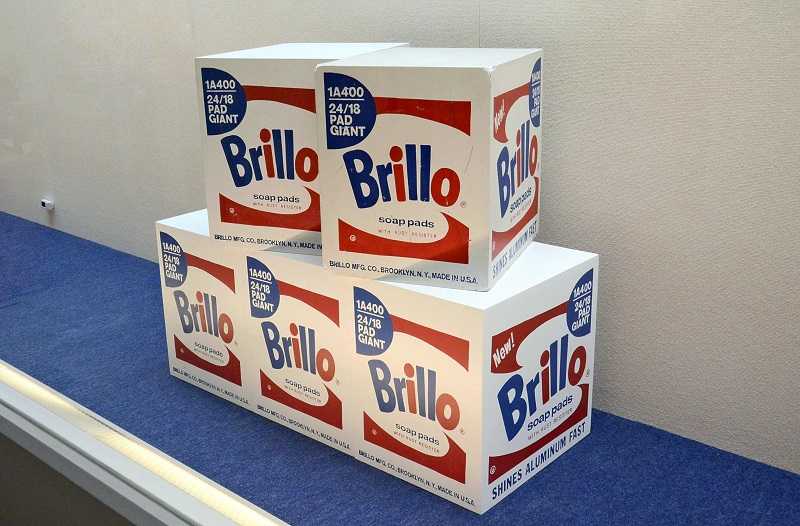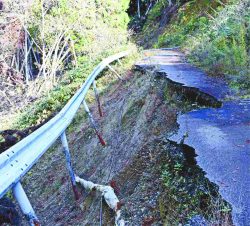
“Brillo Boxes” by Andy Warhol are seen in Tottori. Warhol produced the box on the top right in 1968.
13:53 JST, October 30, 2022
TOTTORI — Tottori Prefecture has created a stir after spending almost ¥300 million to buy five of Andy Warhol’s “Brillo Boxes.” Though the purchase has raised expectations for a prefectural art museum scheduled to open in 2025, some have called the cash splurge into question, forcing the prefecture to hold explanatory briefings for residents.
“Brillo Boxes” (1964) are copies of packaging used for Brillo scouring pads in the United States. Observers say the boxes were a commentary on U.S. popular culture during a period of robust economic growth. Warhol made many copies of the wooden cubes, which are said to have influenced how artistic value is perceived.
The prefecture spent ¥291.45 million on the boxes — slated to be displayed in the newly built museum in the prefectural city of Kurayoshi — in hopes that the pop-art works, said to be coveted by larger museums, can help the prefecture raise its profile. One box cost more than the others — some ¥68.31 million — because it is a relatively rare 1968 example. The other four, priced at ¥55.78 million each, were produced in 1990 with Warhol’s permission by a museum affiliate involved in an exhibition of his works prior to his death in 1987.

Andy Warhol in 1976
According to the prefecture’s board of education that holds jurisdiction over the new museum, no other Japanese museum has a Brillo Box.
“In addition to their crowd-drawing potential, [the boxes] will have an educational effect, helping visitors look at things flexibly from a new perspective,” a board official said.
Warhol is known for various iconic works, such as prints based on photos of Marilyn Monroe and Elvis Presley. His portrait of Monroe fetched $195 million (about ¥25.4 billion) at auction in New York in May.
Warhol (1928-87) remains very popular in Japan, too. About 280,000 people visited the “Andy Warhol: 15 Minutes Eternal” exhibition at Mori Art Museum in Tokyo, during an about three-month run in 2014.
Questions raised
Some, however, have called the purchase into question. Under the existing ordinance, the prefecture requires approval from the prefectural assembly when purchasing movable property costing ¥70 million or more. But the ordinance did not apply to the Brillo Boxes because the prefecture acquired them one at a time.
Prior to the boxes’ purchase in July, the prefecture bought another Warhol piece, a three-dimensional work based on the artist’s signature work, “Campbell’s Soup Cans,” for ¥45.54 million. Neither purchase is legally dubious or problematic as the prefecture received approval from an external committee of experts.
Nevertheless, when the prefecture submitted a report on its Brillo Boxes purchase plan in July, some prefectural authorities were opposed to the idea.
“They’re not familiar to Japanese people at all,” said a prefectural assembly member during a prefectural assembly session in September. “They’re only relevant in the United States.”
Disgruntled board of education members added: “There are people who feel that ¥300 million is way too expensive.” “Why do you need five, and not just one?”
However, the board of education’s Shinichiro Osaki, who in charge of fine-art promotion, said “[Brillo Boxes] represents the United States in the 1960s when mass production and mass consumption became possible in the country. There’s no point in owning just one.”
Meanwhile, Hideki Ashiba, the head of education at the prefectural government, said, “The explanation of our policy regarding collecting artwork didn’t go far enough.”
The briefing held by the prefecture in Kurayoshi and Tottori City drew about 100 people each. Some people who were against the acquisition of the boxes expressed harsh opinions, such as, “I don’t understand their value even when I look at them” and “Replicas would’ve been perfectly fine, apart from the one produced during [Warhol’s] lifetime.”
But others were more forward-looking offering such opinions as, “It’s amazing that I could see the real thing in Tottori,” and “They can be ‘treasure boxes’ depending on how they’re used.”
A board of education head official said, “We’ll offer more detailed explanations on why it was necessary to purchase each of the pieces.”
Junko Iwabuchi, visiting professor of Aoyama Gakuin University and a specialist in the operation and management of art museums, opined: “It’s a matter of course for art museums to aim for a top-level art collection, so the amount spent on each purchase shouldn’t be seen as a problem. But why has the museum chosen pop culture as its collection theme? That requires explanations capable of winning over prefectural residents. Once the museum has opened, it’ll need to continually strive to let people know about the value of its artworks through the use of digital materials and rotating exhibitions.”
Focal point
Expensive artworks often act as focal points when a public art museum opens. In 1994, Aomori Prefecture bought three of four “Aleko” theatrical backdrops by Marc Chagall for about ¥1.5 billion — the purchase was criticized by the prefectural assembly as being too expensive.
When the Aomori Museum of Art opened in Aomori in 2006, the prefecture borrowed the fourth “Aleko” work from the Philadelphia Museum of Art and exhibited the four backdrops together. It was the first time for the entire series to be exhibited together at an art museum anywhere in the world. From 2017, the fourth backdrop has been on free, permanent loan at the Aomori museum, and the work its biggest draw.
In 1989, Osaka City bought “Nu Couche aux Cheveux Denoues” (Reclining Nude with Loose Hair) by Amedeo Modigliani at auction for about ¥1.9 billion. The painting was exhibited at the Nakanoshima Museum of Art in Osaka, which opened in February this year. In 2018, another Modigliani nude painting was auctioned for ¥17 billion.
“The values of artworks change with time,” a senior official of the Osaka municipal government said. “They should be evaluated from a mid- to long-term perspective.”
"Society" POPULAR ARTICLE
-

M4.9 Earthquake Hits Tokyo, Neighboring Prefectures
-

Israeli Tourists Refused Accommodation at Hotel in Japan’s Nagano Pref., Prompting Protest by Israeli Embassy and Probe by Prefecture
-

M7.5 Earthquake Hits Northern Japan; Tsunami Waves Observed in Hokkaido, Aomori and Iwate Prefectures
-

Tsukiji Market Urges Tourists to Avoid Visiting in Year-End
-

M5.7 Earthquake Hits Japan’s Kumamoto Pref., Measuring Upper 5 Intensity, No Tsunami Expected
JN ACCESS RANKING
-

Keidanren Chairman Yoshinobu Tsutsui Visits Kashiwazaki-Kariwa Nuclear Power Plant; Inspects New Emergency Safety System
-

Tokyo Economic Security Forum to Hold Inaugural Meeting Amid Tense Global Environment
-

Imports of Rare Earths from China Facing Delays, May Be Caused by Deterioration of Japan-China Relations
-

University of Tokyo Professor Discusses Japanese Economic Security in Interview Ahead of Forum
-

Japan Pulls out of Vietnam Nuclear Project, Complicating Hanoi’s Power Plans
























